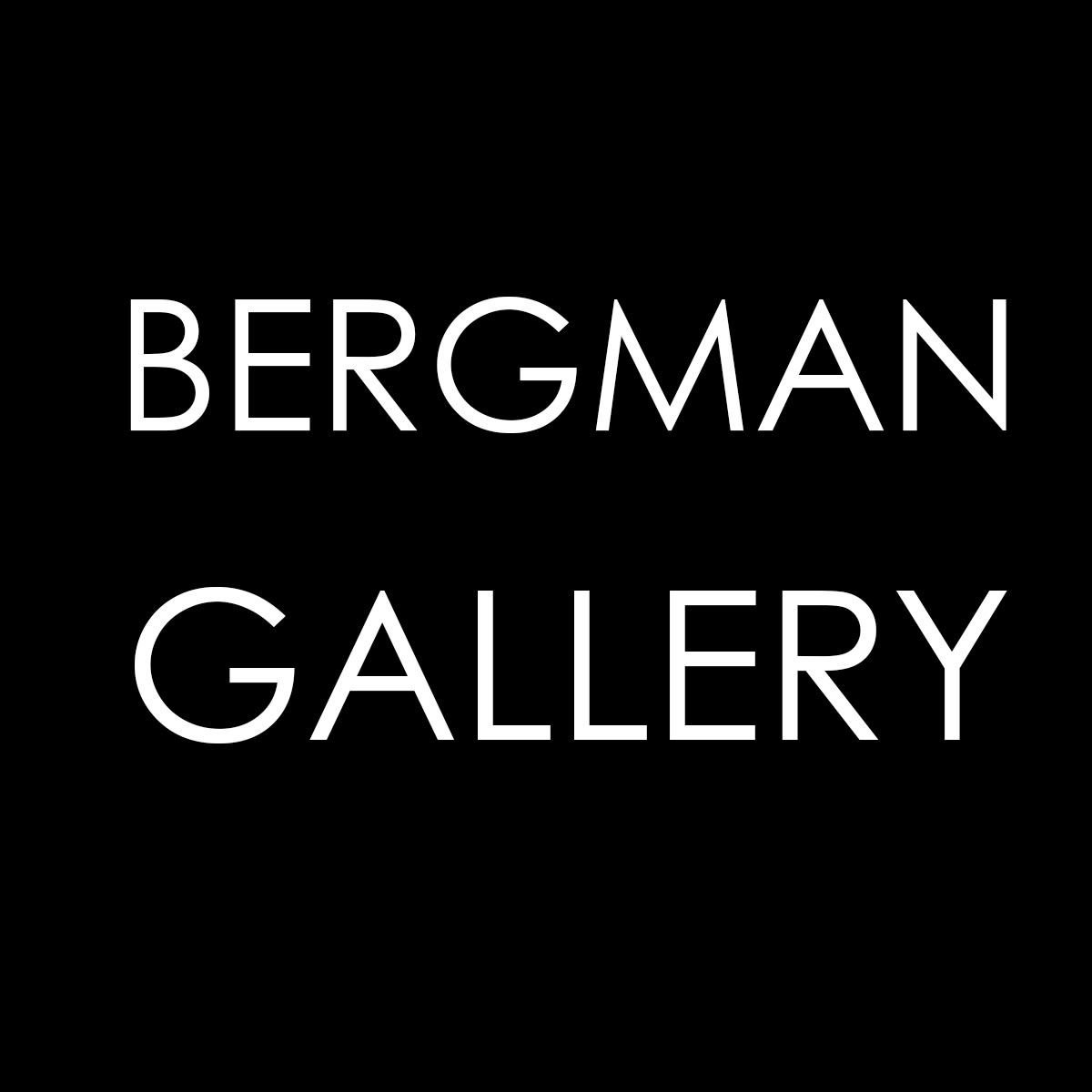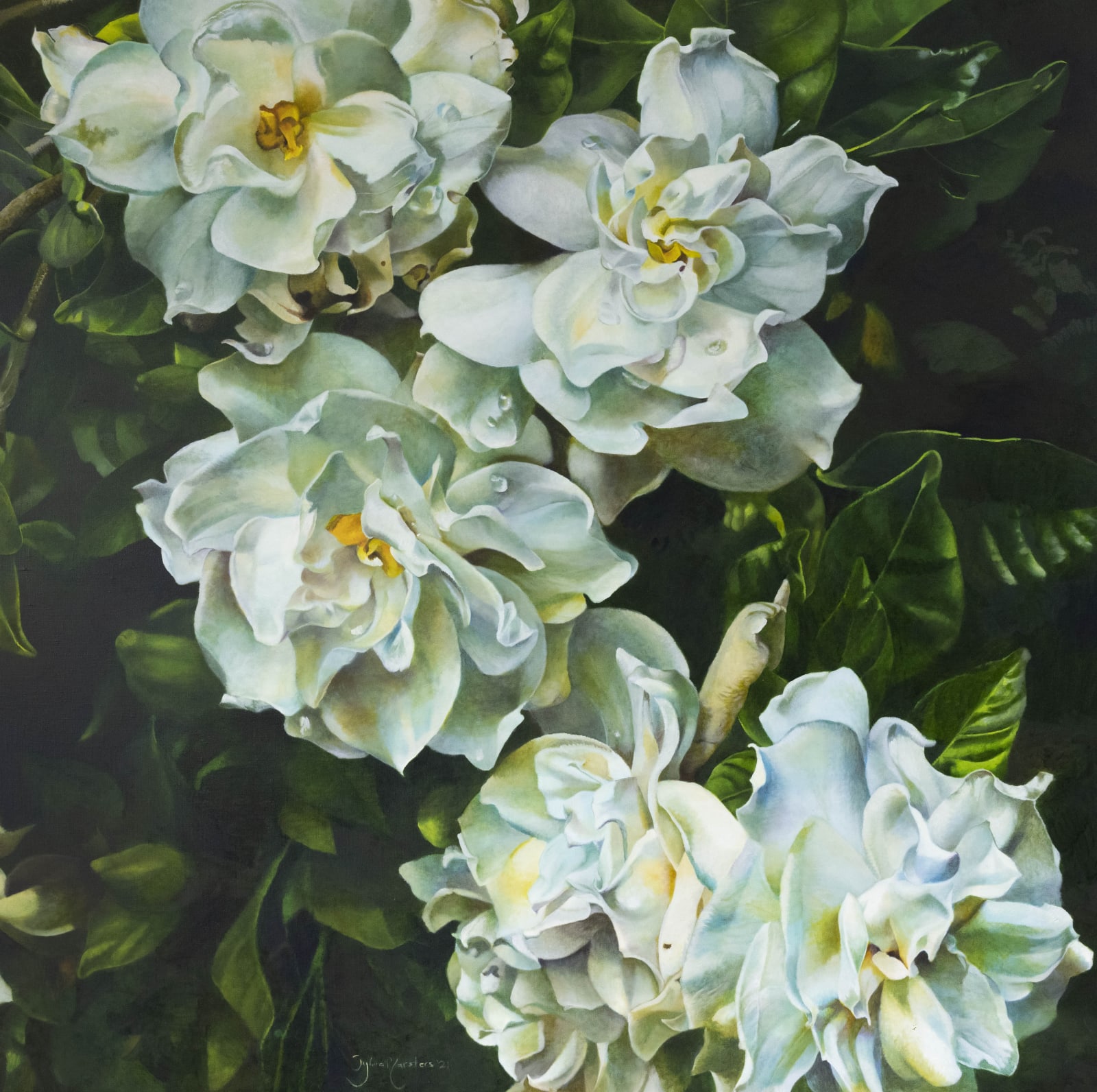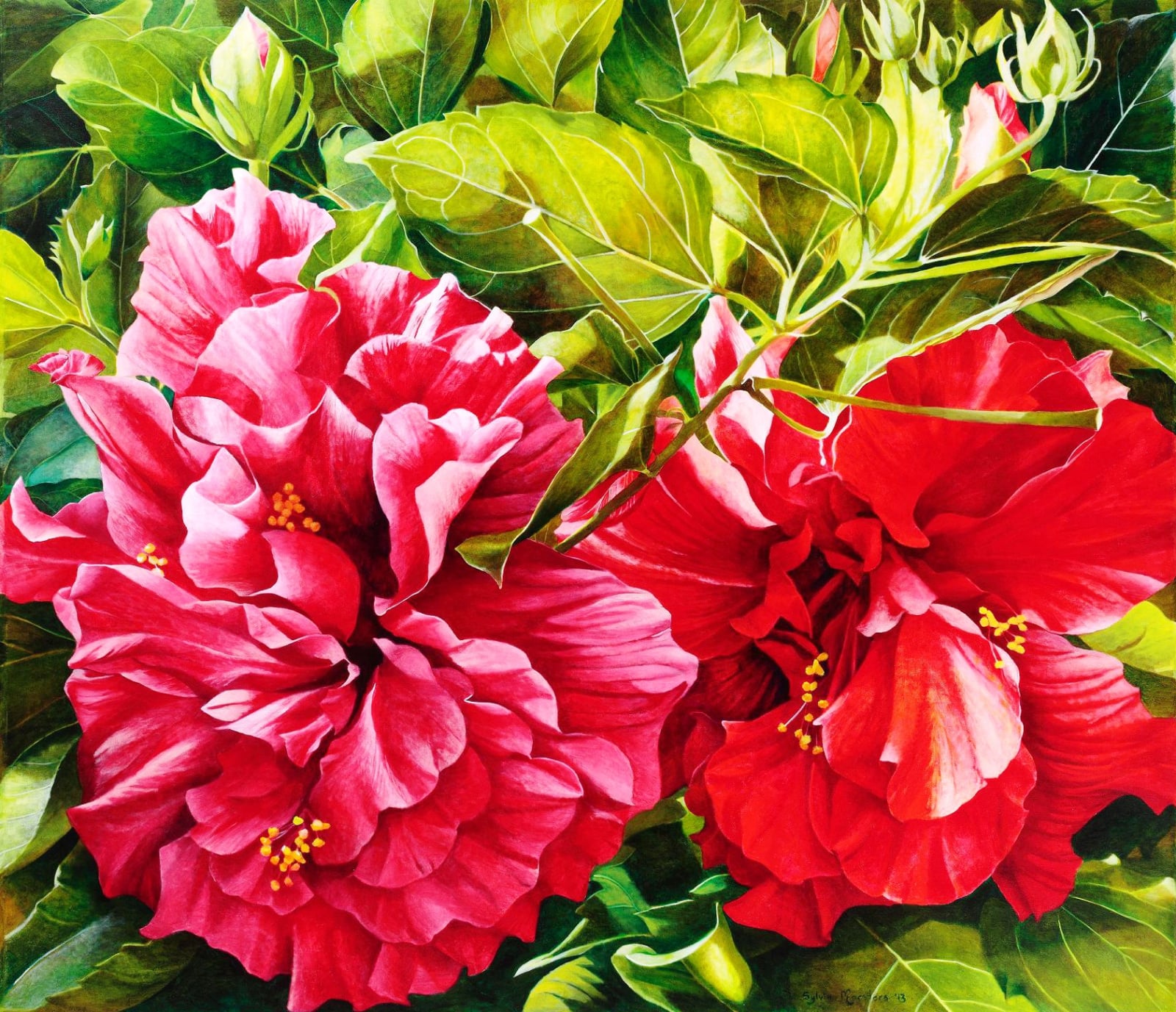In 1946, artist Georgia O’Keefe stated in a New York Post Interview, "When you take a flower in your hand and really look at it, it's your world for the moment. I want to give that world to someone else. Most people in the city rush around so, they have no time to look at a flower. I want them to see it whether they want to or not."
It was a statement that had long fascinated New Zealand | Cook Islands artist Sylvia Marsters and, via well timed opportunity, her exhibition New Yorkers Don’t See Flowers was developed for the VOLTA Art Fair, New York City, March 2014. Recollecting photographer Alexander Liberman’s impressions of a serene vase of flowers amongst the chaos within Augusto Giacometti’s Paris studio in 1950, it was Marsters’ intent to convey a sense of psychic relief on a large urban stage. Bright tropical flowers set against a stark cityscape to easily engaged the viewers’ attention, to offer (if ever so briefly) a chance to re-focus and re-frame our daily outlook and perhaps question what is significant and not so significant in our multifarious reality. It is a recurrent theme within Marsters’ practice.
This notion is reinforced when considering Marsters’ up-bringing in the working class suburbs of Auckland, where she bore witness to the tumultuous economic circumstances of the 1980’s and suffered the loss of a parent.
A former student of the godfather of Pacific contemporary art practice Fatu Feu’u and art tutor / New Zealand artist Lois McIvor (McIvor herself was a student of artist Colin McCahon), Marsters’ fascination with tropical flowers first developed as a response to her Cook Islands heritage and was further enhanced as a result of multiple art residencies and exhibitions undertaken in Rarotonga as Creative New Zealand Artist in Residence (2003) and Beachcomber Contemporary Art (BCA) Artist in Residence (2012).
From that 1998 Elam Summer School with Feu’u, Marsters recalls, ‘he was really keen that I explore my cultural inheritance. When I was thinking about the residency to Rarotonga, he grabbed me and whispered, you have to do this, you have to see it, you have to be in your culture.’ Those first 3 months in Rarotonga in 2003 were emotionally painful at times as many Aotearoa born people experience the ‘homeland’ which is the homeland of our ancestors and not our homeland – except in our dreams.
Later that same year, artist, the late Ian Upokoina George, invited Marsters to participate in Paringa Ou – Something Old, Something New, the first exhibition of its kind featuring New Zealand born artists of Cook Islands descent. Pacific Art Lecturer and Author Dr Karen Stenson stated ‘It is from this world many contemporary Pacific artists emerged’, the exhibition also included Ani O’Neill, Rob George, Nia Val Ngaro, Jim Vivieaere, Mahiriki Tangaroa, Michel Tuffery, Ian George , Kay George and Richard Shortland-Cooper amongst others. ‘Paringa Ou addressed perceptions of identity, cultural loss, migration, place, tradition and change.
These contrasts create ambiguity and the need to challenge, to experiment to find one’s place.’ Opening at the Cook Islands National Museum, Rarotonga September 15th, 1998, Paringa Ou then travelled to the Fiji Museum before returning ‘home’ to Aotearoa, opening at Gus Fisher Gallery in March 1999.
Following her residency exhibition Island Fever (BCA Gallery, Rarotonga, 2012), Marsters embarked on the epic journey to reframe O’Keefe’s statement from a Pacific perspective, an intriguing blend of conceptual ideals and environmental settings. If chaos was the desired backdrop, then New York was indeed the perfect setting for Marsters’ flowers. The artists statement was delivered via a 30 foot, nine panel installation, of intense red Hibiscus set against deep green foliage framed by ominous dark spaces, a compelling composition of absorbing colour contrasts and detailed structure; the flowers themselves seemed to leap directly out at the viewer.
It is no surprise that the sublime beauty of Marsters’ flowers so easily engage your attention, she has been painting them for three decades, her CV boasting an impressive collection of 80 exhibitions to date.
Marsters returned to her passion for Gardenias in the exhibitions Tiare Taina (Bergman Gallery Rarotonga, 2019), Introspective (Auckland Art Fair, 2021) and Utopia (Bergman Gallery Rarotonga, 2021). Drawing from her father’s Cook Islands origins and her mother’s obsessive enthusiasm for gardening, the artist has painted Gardenias in increasing detail throughout her career. Universally treasured for its hypnotic scent, thick waxy petal & sculptural form, these regal flowers capture the senses, evoking memory & connection. In Rarotonga, they are ever-present. They are the scent and embodiment of a tropical locale, invoking a fantastical experience of romance, optimism and self. In her Auckland Garden, they are a conduit to Marsters’ Pacific Islands consciousness.
For this series of exhibitions, Marsters’ Gardenias were painted in hyper detail, full evergreen shrubs with white flowers in various stages of bloom, some are buds, and some have reached the end of their brief life spans. The mood of the paintings varied, from surreal to high definition. Within these compositions, Marsters’ debates her sense of place, reconciling past stories of her fathers romanticized Island upbringing with the realities of existence within a structured urban setting held hostage by another crises, a pandemic.
She states, 'the flora of the Pacific maintain significance in my work, they are meaningful, expressive, iconic flowers. Gardenia's possess spiritual qualities. Bright white flowers against a deep green leaf, contrast and capture the eye. Like stars in the night sky, complex forms, forcing a moment of meditation, serenity, stillness and calm. A Utopia. Throughout years of unprecedented change, these intimate compositions hold even more significance. Natures perpetual rhythms transcend religion, politics and an ego's constant chatter, offering an alternative to the dystopian narratives that pervade our world.'
This series of exhibitions dove headfirst into that disconcerting circumstance. Her world (and ours) was being reinvented at a rapid pace. New words, protocols, and ways to relate to each other as a species reached sci-fi proportions. Notions of the ephemeral, life vs. death, fantasy vs. reality, life before and during a pandemic and priorities beyond underpin these paintings. For the viewer, the alluring composition of Marsters flowers provide a temporary respite, a chance to escape, if only for a few moments, to become lost in the wealth of sensation within the canvas.
In her recent twin series of solo exhibitions (E Moemoeā Naku - A Dream of Mine, Bergman Gallery Auckland, 2022) and E Moemoeā Naku 2 (Bergman Gallery, Rarotonga, 2023), Marsters paintings returned in part to the figurative depictions of an earlier body of work. The artists new paintings take on a dreamlike quality, conveying a viewing experience halfway between the visible and invisible, offering glimpses of everyday Island scenes, real and imagined. The artist and viewer are voyeur, never quite part of the scene depicted.
But the flowers were still present, worn on the head as iconic ‘Ei Katu’, or behind the ear as is the classic island fashion, in the buckets at the market, or moving in the breeze as you look beyond the Hibiscus Hedge to the scene playing out, and as patterns, sewn into the fabric of the delicate summer dresses worn by the occupants of the paintings.
There is a dreamy feeling of nostalgia present, peace and contentment permeate these works.
Sylvia states ‘returning to solo exhibition in Tāmaki Makaurau after a long hiatus, made me realise the significance of my time in the Cook Islands. Floral paintings represent my relationship with my surround, the Hibiscus primarily for their iconic representation of the Pacific Islands, and the Gardenia, an obsession throughout my art practice. The recent figurative paintings in E Moemoeā Naku offer a glimpse into my relationship with Rarotonga encapsulating treasured moments of daily life. These paintings pay tribute to exhibitions that have been held in Rarotonga over the years, offering a glimpse into this journey, this dream of mine.’




